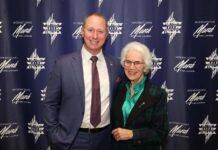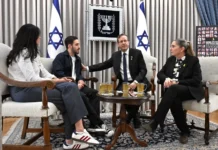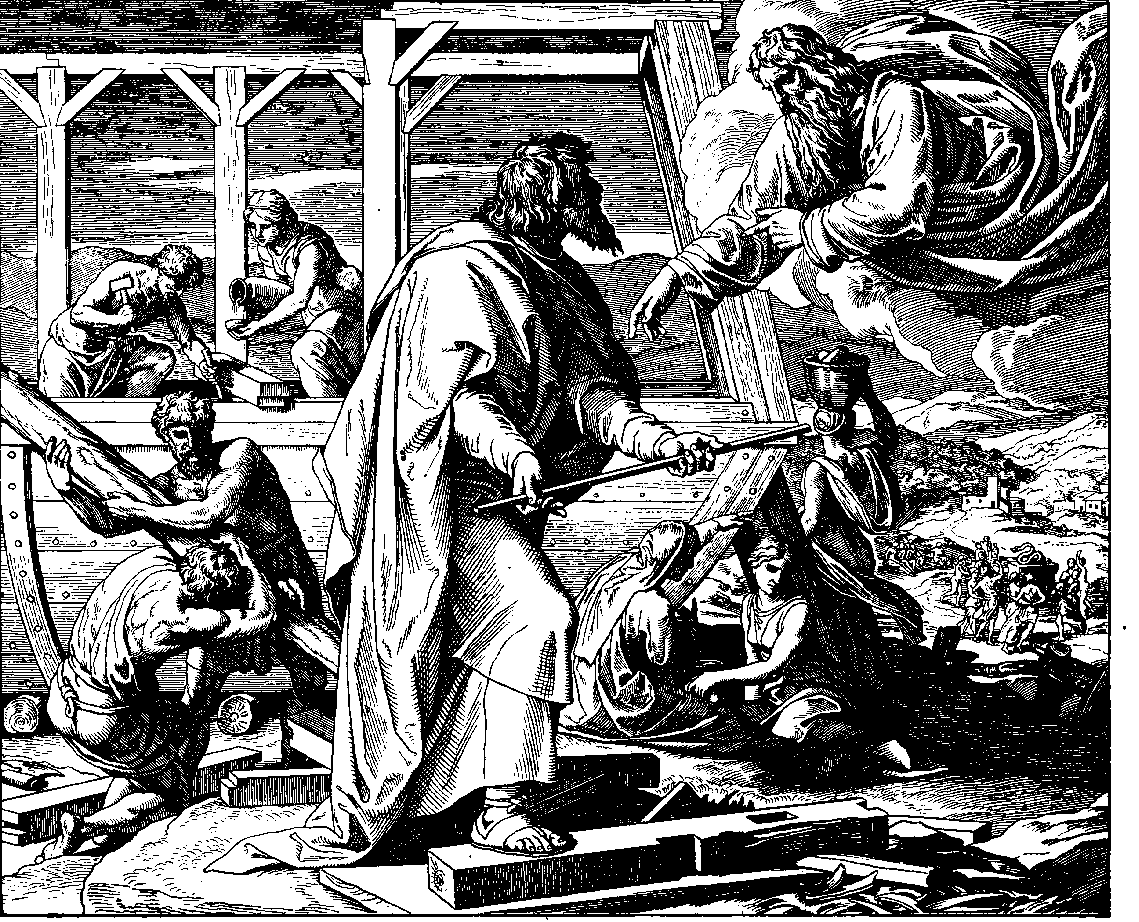Noach was a righteous man a Tzadik (“צדיק”), Tamim (“תמים” – humble), and “walked with HaShem”. The Zohar explains that Noach always had HaShem’s ways lead his path among the wicked people of his generation. We learn this from the words “אֶת-הָאֱלֹהִים, הִתְהַלֶּךְ-נֹחַ”, meaning Noah “walked with God” referring to keeping the seven laws. The word “Et” (“אֶת”) is an acronym of the words Elohim and Torah. In comparing Noach to his generation and to his own family, he was the closest person to HaShem’s ways. Noach’s wife was Naama (“נעמה”, and they had three sons, Shem (“שם”), Cham (“חם”) and Yafet (“יפת”), who later on will have children whose names are past and current nations. Noach was the foundation of the world’s population and the Jewish people (by Shem). We know that from the word “Toledot” (“תּוֹלְדֹת”) as they were the offspring of Noach and the new generations, as HaShem had the covenant with him. The Midarsh explains that Noach was born “complete”, meaning he was born with a Brit-Milah (“ברית מילה” – circumcision) and he was to make the next generations of Jews complete as well.
The Zohar teaches us that mentioning the name Noach (“נֹחַ”) several times (three all together – 3 temples) in the first verse comes to teach us that every Jew will have a portion in “Olam Haba” (“עולם הבא”) in the next world, as it is written in Pirkei Avot: “all Israel have a portion in the next world” (“כל ישראל יש להן חלק לעולם הבא”). We need to always remind ourselves that there are many different portions in “Olam Haba”. The question we should ask ourselves is which portion do we want to have? Since there are several portions in which some of the most dangerous criminals and sinners are placed, we need to ask ourselves if we want to be in such company for eternity. We also learn from this double mentioning of the name of Noach that we should aspire to be like him with modesty and Torah studies, as it say, “He was a Tzadik (righteous) and walked with Hashem”. The name Noach also spells the word “Chen” (“חן”), which means secret, as it is the acronym for “Chochmat Nistar” (“חכמת נסתר”), the hidden wisdom that Noach possessed. Noach was given this name because it was a direct reflection of his spiritual character. Noah is derived from the Hebrew word Nechamah, which means to console. Noach’s spiritual work and destiny was to console the earth in the aftermath of the flood and the destruction of the world. This great spiritual mission, expressed through his name, was Noach’s connection to the Light of the Creator. The Zohar explains that our name, too, is our bridge and link to the Creator.
From calling the name of Noach (“נֹחַ”) twice we learn also that he had two “Ruchot” (spirits); one for this world and one for the next world. Our Forefathers, Avraham and Yaakov, as well as future Tzadikim like Moshe and the Prophet Shmuel, all had access to both worlds at the same time. They were all called by HaShem with their names twice; for example, “Moshe Moshe”. We learn that Yitzchak did not have such ability since his earthly “Ruach” (soul) left him at the “Akeida”, when he was placed on the Alter to be sacrificed. Avraham had the ability to bring back dead people back, but upon seeing his son’s soul leaving him he prayed to HaShem “Baruch Mechaye Hametim” (“ברוך מחייה המתים” – blessed be HaShem who brings back from the dead). We say this every morning during “Shacharit” after mentioning Avraham’s name to remind ourselves of the great miracle we are privileged to experience every day. Yaakov had done the same when he was reunited with Yosef after twenty-two years. The Talmud teaches that one who sees a good friend after a period of more than 30 days should recite a special blessing, the blessing of he’hecheyanu: “בָּרוּךְ אַתָּה יְהוָה אֱלֹהֵינוּ מֶלֶךְ הָעוֹלָם,שֶׁהֶחֱיָנוּ וְקִיְּמָנוּ וְהִגִּיעָנוּ לַזְּמָן הַזֶּה”.
We notice that HaShem placed Shem’s name first even tough he wasn’t the firstborn, as we see in the first verse “אֶת-שֵׁם, אֶת-חָם וְאֶת-יָפֶת”. HaShem points out that His jewish children are truly considered firstborn as they are His Chosen People.
The Gemara (Eruvin 13:2) teaches us about the discussions that took place for two and a half years in regards to having Noach’s name mentioned twice. The Gemara explains that Beit Shammai and Beit Hillel were divided whether it was better for human to be born or not, as it says, “those say, ‘It is more convenient for a person if he was not created more than if he was created’; and those say, ‘It is more convenient for a person that he was created than if he was not created’. They counted votes and concluded, ‘It is more convenient for a person if he was not created, more than if he was created’; Now that he was created, “יפשפש במעשיו” Yefashpeish Bemaasav. And others say “ימשמש במעשיו” Yemashmesh Bema’asav”.
שתי שנים ומחצה נחלקו ב”ש וב”ה. הללו אומרים, “נוח לו לאדם שלא נברא, יותר משנברא.” והללו אומרים, “נוח לו לאדם שנברא, יותר משלא נברא.” נמנו וגמרו, “נוח לו לאדם שלא נברא, יותר משנברא.” עכשיו שנברא, יפשפש במעשיו. ואמרי לה: ימשמש במעשיו
Our Sages explain “יפשפש במעשיו – Yefashpesh Bema’asav”: that which he already did, check the sins that were in his control, confess, and do Teshuvah. “Yemashmeish Bema’asav”, meaning if a mitzvah reached his control, he should consider the loss the mitzvah would incur against its reward, and not rest from doing it because of that loss for the reward he will receive in the future. If an “Aveirah” comes under his control, he should think of the reward he is going to gain from it now against the future loss, and to separate from it.
Our Sages point out that having the Torah mentions Noach’s name three times in the first verse, teaches us that Noach saved three sets of people, as he saved his three sons and their future offspring. By having Noach’s name mentioned twice “נֹחַ—נֹחַ” our Sages explain that HaShem creates both greatness above and below, alluding to earth and heaven. We learn from the word “Haya” (“הָיָה” – was) a future prophecy and a message about Avraham. The numerical value of the word “Haya” is 20, which teaches us that Avraham would come 20 generations after Noach.
In verse 6:14 the writing of the word “Ark” is strange “תֵּבַת”. It is written as “Teivat” and not “Teva, as it says, “עֲשֵׂה לְךָ תֵּבַת” (Make yourself an Ark). This, so called mistake is actually a teaching by HaShem to Noach of future holy elements. HaShem revealed to Noach the future covenants the Jewish people will have with HaShem, as the word “Teivat” (“תֵּבַת”) stands for:
It worth mentioning here that the word the תבת “Tievat” (Ark) has a hidden code within its acronym:
- The letter ת “Taf” stands for the תורה Torah
- The letter ב “Bet” stands for ברית מילה Brit-Milah
- The letter ת “Taf” stands for the תפילין Tefillin
Another reason Noach’s name is mentioned three times is to teach us that he saw three worlds; before, during and after the Mabul (“מבול“ – the flood). HaShem saw all the sinners in the world for the past fifteen hundred years and decided to start over, using the flood to destroy the world. HaShem also showed Noach the other reason for Bnei-Yisrael meriting a portion in “Olam Haba” (“עולם הבא”), in the next world. HaShem showed him the Mitzvah of “Brit-Milah” (“ברית מילה” – circumcision) and His covenant with the people of Israel. The Zohar says that the boat that saved Noach from the flood is actually the Torah as it was placed in the Ark of holiness. Noach resembles the “Brit-Milah” between HaShem and Israel as He made it a covenant and oath for eternity.
We also see that HaShem in the last Parasha placed a limit of 120 years, yet Noach was over 500 years old while having his children. Rabbi Roi explains that HaShem was hinting to his children that true Teshuvah he can change a decree, as Noach did.
It worth mentioning here that now after HaShem revealed the there covenants He changed the last letter (from ת “Taf” ) to “ה” (Hei) in order to protect the ark just as he will do with many righteous people in the future. The word the תבה “Tieva” (Ark) has a hidden code within its acronym:
- The letter ת “Taf” stands for the תורה Torah
- The letter ב “Bet” stands for ברית מילה Brit-Milah
- The letter ה “Hei” stands for “ה” HaShem
This alludes to the elements of covenant between HaShem, Noach (and his offerings) and the Torah.
The three signs of oath “Ott” (“את”) HaShem have with Bnei-Yisrael, as it says, “אות היא לעולם ביני ובין בני ישראל”, spell the word Shabbat (“שבת”):
- “ש” stands for Shabbat (“שבת”)
- “ב” stands for Brit-Milah (“ברית מילה”)
- “ת” stands for Teffilin (“תפילין”)
Noach’s generation sinned in many ways, including immorality (both immoral behavior with family members and with strangers), bestiality, sex crimes, mate exchanging and many more horrific sins. The Midrash says that even the animals were sinning, as they too had relationship with other kinds of animals, as well as with humans. The Midrash says that in those generations there were giants who lived for a very long time and they never lost a child while alive. Their children were conceived and born on the same day ready to walk and speak (just like in the animal kingdom). They also lived to see their great-grandchildren children, and only had to plant and harvest their fields once every forty years. Because of their horrific sins HaShem reduces their life span to only one hundred and twenty years at the most.
According to our Sages the weather was always perfect in their time, no excessive heat or cold ever existed. They also felt as if they cannot be destroyed since they felt proud and ungrateful due to their God-given physical stature. The mighty beasts like lions and tigers were afraid of them, as they were powerful giants who ruled the world. They felt that they do not need HaShem anymore, even for getting water, and they believed in themselves more than in HaShem. This was the main reason why HaShem punished them with water as it was “Measure for Measure”. Only after the Mabul, HaShem created the four seasons, and extreme weather. Our Sages say that the Mabul was like a “Mikvah” (“מקווה” – immersion in water) in order to purify that sinful world.

























